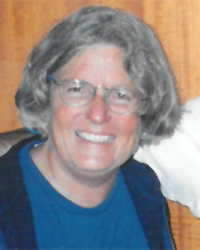Queen’s community remembers former staff member Mary Fraser
April 29, 2022
Share
 The following Lives Lived is written by Matthew M. Reeve, a professor and colleague of Mary Fraser in the Department of Art History.
The following Lives Lived is written by Matthew M. Reeve, a professor and colleague of Mary Fraser in the Department of Art History.
Mary Fraser died peacefully on April 13 in the presence of her close friends Jesse Archibald, Rev. Susan Davies, and Mary Jane Kingston. She was 80.
Mary was a longstanding member of the Queen’s community, serving as the coordinator of the Visual Resources Unit at the Department of Art. She was also president of the Queen’s Staff Association (1988-90), representative to the Board of Trustees, and vice-president of the Gallery Association of the Agnes Etherington Art Centre. In the Art Department (as it was called in her time), she held memorable “coffee clutches” (nearly mandatory lunchtime meetings for faculty and staff), and built up what is the strongest art exhibition catalogue collection in Canada. But such a list obscures rather than reveals the extraordinary person that Mary was. Her personality and life are the things of poetry that easily elude the confines of a conventional obituary.
She was the granddaughter of William Hugh Coverdale, early and influential collector of Quebec art and CEO of Canada Steamship Lines, who purchased the family estate at Lemoine Point in 1918 where Mary lived most of her life. Coverdale was himself a native son of Kingston and the grandson of William Coverdale, architect of the Kingston Penitentiary and a list of other prominent buildings in the city. Mary’s local roots ran deep, but her mindset was overtly international.
Mary studied at Wellesley College in Massachusetts, and the University of Toronto for her BA, which she earned in 1964. She fell in love with medieval sculpture and moved to London to work with the doyen of English Romanesque art, the eminent Polish scholar George (Jerzy) Zarnecki (1915-2008). I was surprised to learn this as a young medievalist myself when I first appeared at Queen’s in 2003 fresh from Cambridge. She would recount many tales of her London days over dinner in subsequent years. Before moving to England in 1971, Mary met Peter Fraser, a Scottish art historian and her future husband, who had himself worked under the illustrious (and infamous) Sir Anthony Blunt at the Courtauld Institute. After a year of study in London, Mary knew that her heart resided with Peter and Lemoine’s Point, so she packed in her degree to return home, get married, and become the steward of Lemoine’s Point Farm.
Peter and Mary had an unwavering love for each other, and the material precipitate of that love is still manifest in some of the physical remains of their shared passions. First was their art collection of Canadian, Scottish, Continental Baroque and Rococo paintings and drawings, objects and furniture that ornamented the houses of Lemoine’s Point. Mary left parts of her collection of art and objects to the Agnes Etherington Art Centre and to the Marine Museum of the Great Lakes. Second was their love of sailing. Mary and Peter spent many summers in the Mediterranean racing, exploring, and living on the ocean, before they moored their boat permanently in Halifax where, after Peter’s passing, Mary and friends sailed each summer. Third was an unwavering conviction that life was for living and enjoying, and this very conviction fuelled the dazzling social life at Lemoine Point, which hosted a thousand dinner parties — some that cleared the wine cellar — with friends and family. For Mary, her friends were very much her family, and she was blessed to have a long list of loyal, loving friends with whom she traveled, visited, and generally shared her life.
Her genealogy alone might have made a lesser person a snob or a socialite, but Mary was resolutely neither. As the owner and manager of an active farm of Highland cattle, sheep and other creatures, Mary had deep knowledge of the animals she cared for and the complex science of agriculture itself. Mary rode the big horses in the farm's display at the Kingston Agricultural Fair each year and fended off more than one interloper onto the farm on horseback. She loved the lambing season when she slept on the blue sofa in front of the fireplace ready to dash out to the barn to help the ewes bring new lambs into the world. Mary could hoist bails into the hayloft with the brawny strength of an athlete, debate the finer points of a medieval manuscript leaf with the acuity of a connoisseur, tie off a sailor’s knot better than any deckhand, discipline her many border collies like a schoolmistress, or cook a fast risotto that would have made even Julia Child nervous. She approached all of this with tremendous humour and never failed to see the comical and ridiculous of any situation. Simply put, she was unlike anyone else I ever met.
Never suffering fools, but embracing and holding onto the people she loved, Mary was a dear friend to many. She leaves behind her nephews and nieces and many, many friends who love her.
A memorial service will be held July 9.